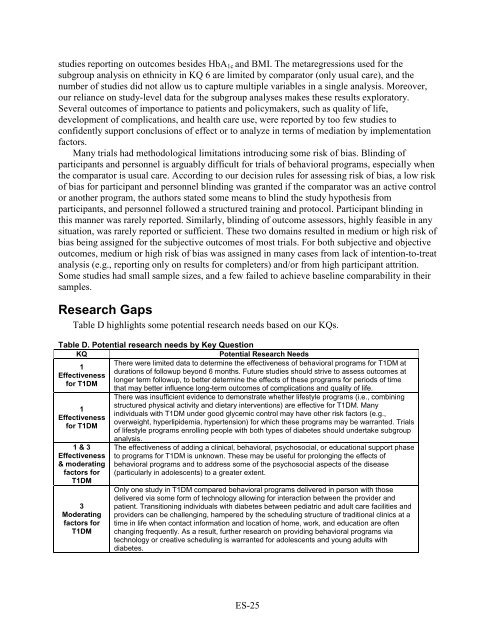Behavioral Programs for Diabetes Mellitus
diabetes-behavior-programs-report-150924
diabetes-behavior-programs-report-150924
- No tags were found...
You also want an ePaper? Increase the reach of your titles
YUMPU automatically turns print PDFs into web optimized ePapers that Google loves.
studies reporting on outcomes besides HbA 1c and BMI. The metaregressions used <strong>for</strong> the<br />
subgroup analysis on ethnicity in KQ 6 are limited by comparator (only usual care), and the<br />
number of studies did not allow us to capture multiple variables in a single analysis. Moreover,<br />
our reliance on study-level data <strong>for</strong> the subgroup analyses makes these results exploratory.<br />
Several outcomes of importance to patients and policymakers, such as quality of life,<br />
development of complications, and health care use, were reported by too few studies to<br />
confidently support conclusions of effect or to analyze in terms of mediation by implementation<br />
factors.<br />
Many trials had methodological limitations introducing some risk of bias. Blinding of<br />
participants and personnel is arguably difficult <strong>for</strong> trials of behavioral programs, especially when<br />
the comparator is usual care. According to our decision rules <strong>for</strong> assessing risk of bias, a low risk<br />
of bias <strong>for</strong> participant and personnel blinding was granted if the comparator was an active control<br />
or another program, the authors stated some means to blind the study hypothesis from<br />
participants, and personnel followed a structured training and protocol. Participant blinding in<br />
this manner was rarely reported. Similarly, blinding of outcome assessors, highly feasible in any<br />
situation, was rarely reported or sufficient. These two domains resulted in medium or high risk of<br />
bias being assigned <strong>for</strong> the subjective outcomes of most trials. For both subjective and objective<br />
outcomes, medium or high risk of bias was assigned in many cases from lack of intention-to-treat<br />
analysis (e.g., reporting only on results <strong>for</strong> completers) and/or from high participant attrition.<br />
Some studies had small sample sizes, and a few failed to achieve baseline comparability in their<br />
samples.<br />
Research Gaps<br />
Table D highlights some potential research needs based on our KQs.<br />
Table D. Potential research needs by Key Question<br />
KQ<br />
Potential Research Needs<br />
1<br />
Effectiveness<br />
<strong>for</strong> T1DM<br />
1<br />
Effectiveness<br />
<strong>for</strong> T1DM<br />
1 & 3<br />
Effectiveness<br />
& moderating<br />
factors <strong>for</strong><br />
T1DM<br />
3<br />
Moderating<br />
factors <strong>for</strong><br />
T1DM<br />
There were limited data to determine the effectiveness of behavioral programs <strong>for</strong> T1DM at<br />
durations of followup beyond 6 months. Future studies should strive to assess outcomes at<br />
longer term followup, to better determine the effects of these programs <strong>for</strong> periods of time<br />
that may better influence long-term outcomes of complications and quality of life.<br />
There was insufficient evidence to demonstrate whether lifestyle programs (i.e., combining<br />
structured physical activity and dietary interventions) are effective <strong>for</strong> T1DM. Many<br />
individuals with T1DM under good glycemic control may have other risk factors (e.g.,<br />
overweight, hyperlipidemia, hypertension) <strong>for</strong> which these programs may be warranted. Trials<br />
of lifestyle programs enrolling people with both types of diabetes should undertake subgroup<br />
analysis.<br />
The effectiveness of adding a clinical, behavioral, psychosocial, or educational support phase<br />
to programs <strong>for</strong> T1DM is unknown. These may be useful <strong>for</strong> prolonging the effects of<br />
behavioral programs and to address some of the psychosocial aspects of the disease<br />
(particularly in adolescents) to a greater extent.<br />
Only one study in T1DM compared behavioral programs delivered in person with those<br />
delivered via some <strong>for</strong>m of technology allowing <strong>for</strong> interaction between the provider and<br />
patient. Transitioning individuals with diabetes between pediatric and adult care facilities and<br />
providers can be challenging, hampered by the scheduling structure of traditional clinics at a<br />
time in life when contact in<strong>for</strong>mation and location of home, work, and education are often<br />
changing frequently. As a result, further research on providing behavioral programs via<br />
technology or creative scheduling is warranted <strong>for</strong> adolescents and young adults with<br />
diabetes.<br />
ES-25


